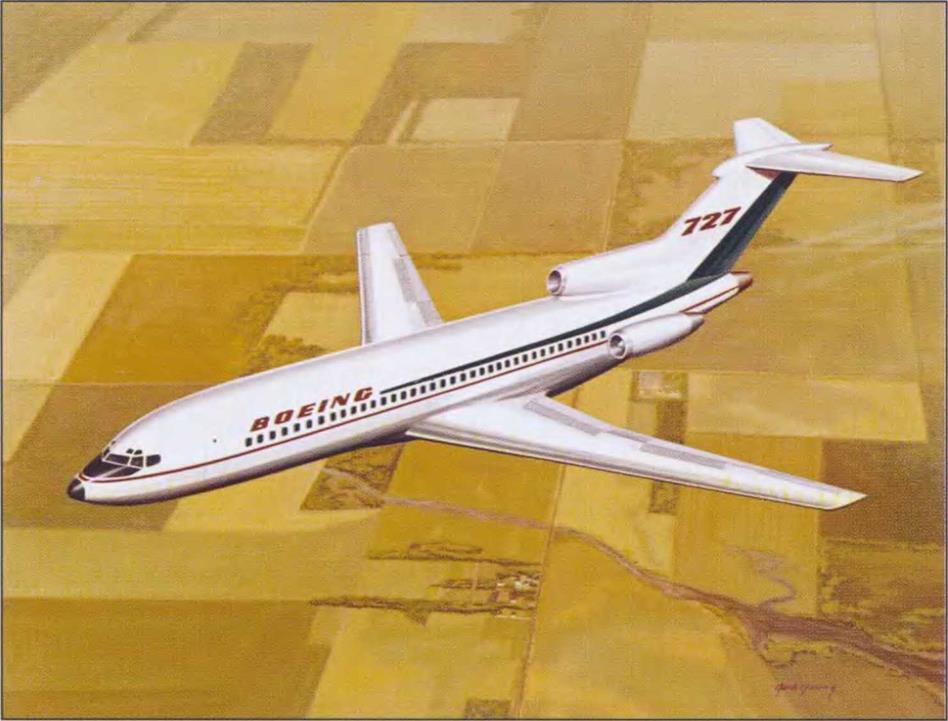Smaller Jetliners in the mid-1960s
While the brilliant French Sud Caravelle became the Western world’s first short – to medium-range jetliner in the late-1950s, a new flock of twinjet and tri-jet airplanes emerged in the following decade bringing significant advances in airframe, powerplant, and systems technology. In 1962 Britain’s Hawker Siddeley Trident became the first new smaller jetliner to take flight after the original Caravelle, but it was another three-engine design from Seattle that truly launched medium-range jet-powered service two years later. Boeing’s 727 was a revolutionary airplane when first flown, bringing jet speed, comfort, and convenience to smaller regional airports previously served by DC-6s, Constellations, and even Convair-Liners. With a total of more than 1,800 built in two basic models and operated by major carriers all over the world, the 727 was the most successful
airliner ever flown at the time, becoming the undisputed DC-3 of the Jet Age.
After a failed marriage between Sud and Douglas to market the Caravelle in the United States, Douglas developed its own twinjet airliner called the DC-9, which entered service in 1965. Starting as a 100-seater known as DC-9-10, the basic design grew in typical Douglas fashion all the way to the Series 50. The next step was a rather big one, when the latest iteration became the DC-9 Super 80 with larger engines, wings, tail, landing gear, and a stretched fuselage that held up to 165 passengers. The most advanced airliner of its time, the Super 80 was renamed the MD-80 (MD standing for McDonnell Douglas, replacing the classic DC, or “Douglas Commercial” designation) and grew into the MD-90, and the shorter-fuselage MD-87. The final member of the family was originally called the MD-95, a name that morphed into the Boeing 717 when that company acquired McDonnell Douglas in 1997.
Meanwhile, in England, the newly established British Aircraft Corporation (ВАС) designed a small twinjet for inter-European routes that eventually became a DC-9 competitor. Called the ВАС 111, it entered service in 1965. Ironically, this airplane was flown in the United States, as well, by American, Braniff, and Mohawk to connect those carriers’ smaller cities to their 707 and DC-8 trunk routes.
By 1968, Boeing was building a shorter, twin – engine feeder liner of its own called the 737, launched by Lufthansa and first operated in the United States by United Air Lines, ironically replacing aging Caravelles on United’s routes. In a classic example of how dramat-
|
Bringing jet service to the world’s smaller cities was the Boeing 727, which entered service in 1963. With more than 1,800 built, the 727 was to the Jet Age what the Douglas DC-3 was to the late-1930s—a machine that could make a profit for companies flying passengers to destinations all over the world. Many are still flying today. (Boeing/Jon Proctor Collection) |
ically things can change in the airline industry, the modest and stubby little 737 grew in size, power, range, and passenger capacity over the years, and is now flying in its third design makeover, glass cockpit and all. With more than 6,000 delivered (and another 2,000 currently on order), the 737 has become the most successful singleaisle jetliner in history. To put all this in proper perspective, the latest version in the 737 series can carry more passengers over longer distances on two fewer engines and with two fewer flight crew than Boeing’s original 707 could when first introduced in 1958!











